Tasers, training exercises and a 200-question test. Canton police cadets at the academy
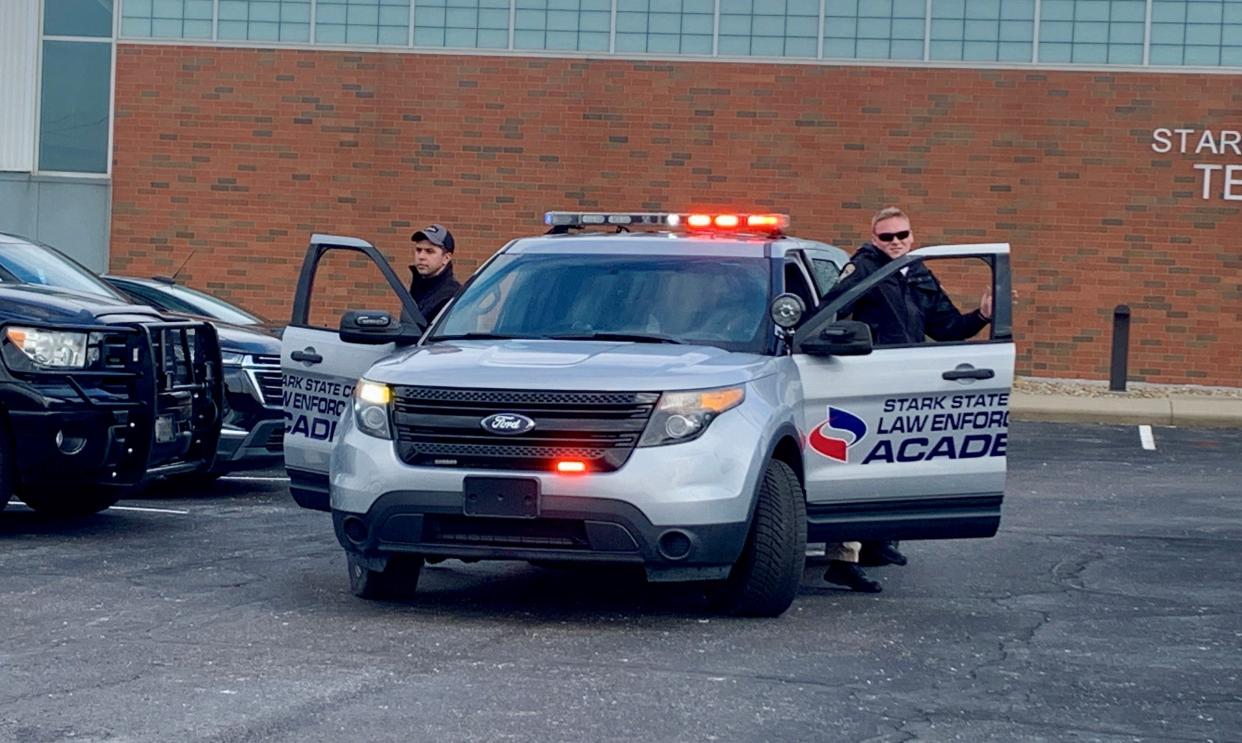
Editor’s note:To better understand the challenges facing police departments and new recruits, The Canton Repository has been following three of Canton City’s police cadets for their first year on the job.
With permission from Canton City Police Chief John Gabbard, cadets Brandon Robb, Jamaal McClain and Ty Cowling have agreed to share their challenges and accomplishments, starting from July 25 when they took their oath of office to their one-year anniversary.
Today’s story — the second in the series — looks at the cadets' training at the department and police academy.
The training observations for this story occurred between August and April 5, taking place before Canton Township resident Frank Tyson died while in city police custody on April 18.
Future stories will be published as the cadets hit various milestones in their training to become police officers.
CANTON − Before city police officers can use a Taser to subdue a suspect, they must feel the shock themselves.
“I want you guys to feel it so you can be exposed to it, be able to testify about it and be able to have some empathy for those that you may have to use this upon,” police Sgt. Craig Riley told six of the city's newest police cadets last August.
They could pick how long the shock would last: Between 2 and 5 seconds.
Cadet Brandon Robb, a retired Ohio Army National Guardsman with three combat deployments, volunteered first. He chose 5 seconds.
Lying face down on the mat, Robb was flanked by two cadets, one on each side with a knee near his armpit, to prevent his arms from trying to knock out the probes. Riley placed one probe on Robb’s rib cage, and the other on his opposite leg.
The buzz of the activated Taser was nearly as loud as Robb’s response.
“Aaaahhhhh!” he yelled for the entire 5 seconds as the electricity triggered uncontrollable muscle spasms through his legs and lower back.
“... You severely undersold that,” he told Riley as he tried to recover. “It’s bad. I can’t even stand up. That was very, very long.”
Jamaal McClain, a former youth prison corrections officer and Brazilian jiu-jitsu competitor, opted for 2 seconds. The probes were placed on his right leg only to demonstrate a localized shock. It still appeared just as painful, as McClain buried his face into the mat and yelled muffled expletives.
Ty Cowling, a former Lorain County adult probation officer, went last, opting for 3 seconds despite some heckling by his classmates for the 25-year-old to try the maximum. His body writhed in pain as he yelled during the shock. He groaned for another 20 seconds before he rolled over to get up.
“Who would ever want to get (expletive) tased?” he asked rhetorically. His fitness watch said his heart rate jumped to 130.
Riley, a Canton police officer since 1999, assured them that being shocked by a Taser wasn’t as bad as pepper spray.
The cadets would find out on their own the next day.
Glimpse into how new Canton officers are trained
The Canton Repository has been following Canton cadets Cowling, McClain and Robb through their first year on the job to get a better understanding of the challenges new officers face as they transition from a cadet with no arrest powers, to students at the police academy to a commissioned officer responding to their first emergency.
The past eight months have provided a window into how new Canton city police officers are trained.
Police officer training has increasingly come into question in Canton and across the country since George Floyd died in May 2020 while being arrested by Minneapolis police officers.
The April 18 death of Frank Tyson in police custody has resurrected many of the questions about de-escalation and use of force that residents and community activists asked for four years ago when police used tear gas on protesters who were demonstrating after Floyd’s death and asked again in 2022 after a Canton police officer shot and killed James Williams, who was shooting a gun into the air to celebrate the New Year.
State sets minimum police training standards
The Ohio Peace Officer Training Commission, whose 10 members are appointed by the governor with the consent of the Ohio Senate, sets the baseline for police recruit training in Ohio. The commission also certifies Ohio’s roughly 60 law enforcement training academies and sets the standards for academy instructors.
The state has set 740 hours — spread over 60 different topics in 13 different categories — as the minimum amount of training for police recruits hoping to join Ohio’s 30,000 law enforcement officers.
Ohio Peace Officer Training Commission minimum police training standards
Infogram
Prospective police officers must complete every minute of the state-required courses, pass a 200-question written certification exam and finish a minimum number of situps, pushups and a 1.5-mile run within a specified time before they can carry a badge.
Recruits currently spend the biggest chunk of their time — 125 hours or 17% of the academy — learning about traffic enforcement and investigation, such as how to properly issue a traffic ticket, conduct a field sobriety test and accurately measure a vehicle’s speed. They spend 111 hours learning the Ohio Revised Code and court cases that provide the parameters of their arrest powers. The remaining hours are divided among the categories of human relations, subject control techniques, patrol, firearms, investigations, physical conditioning, administration, driving, homeland security, first aid and civil disorders.
A task force assembled in 2023 by Ohio Attorney General Dave Yost has recommended changes to the academy curriculum. The task force believes some of the traffic training, courses on the national incident management system and how to render first aid should be removed and addressed by departments outside the academy.
The 11-member task force, which includes Stark County Sheriff George Maier, suggests adding 48 hours of coursework that focuses on helping officers communicate with the community. Task force members note in their 40-page report that officers entering the field bring fewer communication skills than their predecessors. The state currently requires no communication training in the academy.
Other recommended training topics to add include active shooter and threat response training, critical decision-making, tactical breathing, crisis mitigation and de-escalation. Task force members believe that more virtual reality technology and more scenario-based training should be used to reinforce an officer’s learning. Yost hopes to roll out the new training over two years.
Canton cadets go to the academy
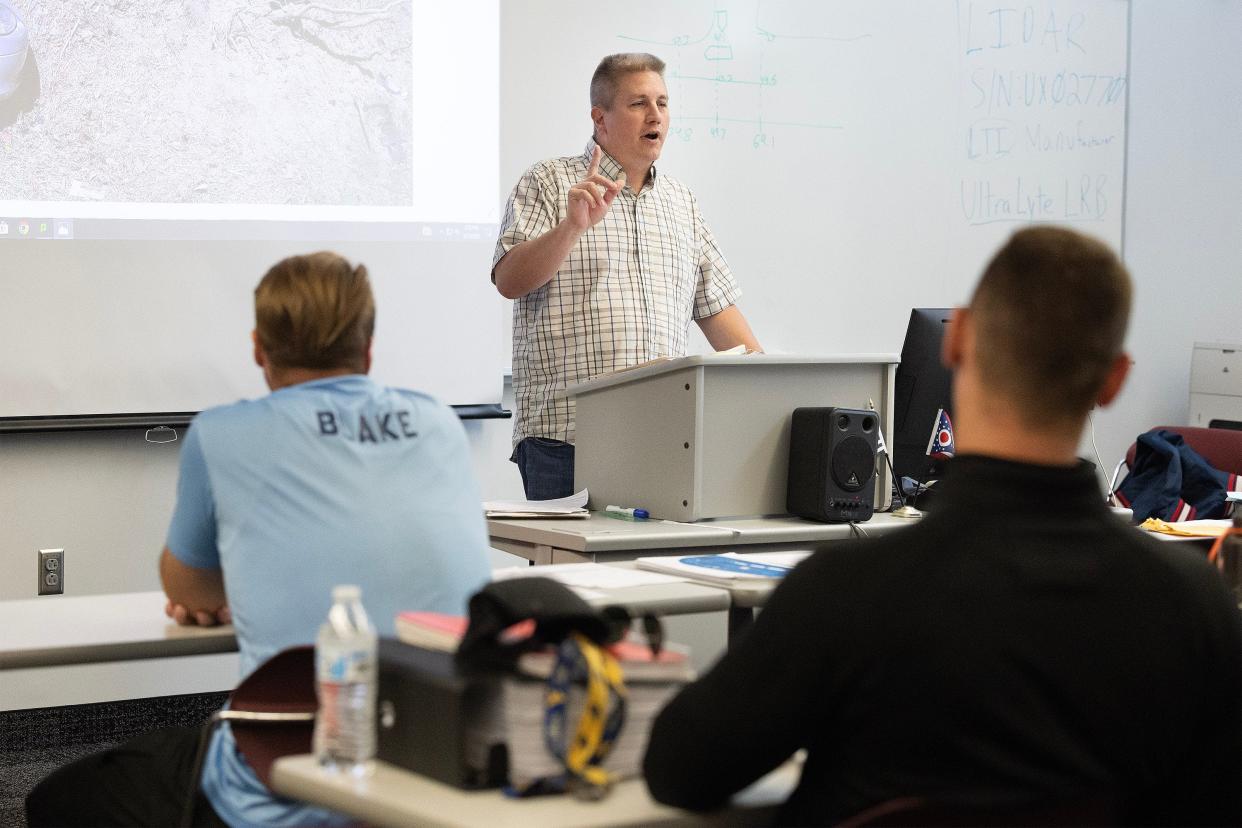
Canton sends its cadets to Stark State College’s law enforcement academy in Jackson Township.
Cadets Cowling, McClain and Robb arrived Sept. 1 at the Stark State College and The Timken Co. Technology and Test Center, which houses the academy on a hill at 8252 Frank Ave. NW that is away from the main college campus.
Joining them in the class were the three other Canton cadets hired on July 25, another city cadet hired in 2022 but has served multiple military deployments that have delayed his training, and three open-enrollment students who had not been hired by a police department. Each student first had to pass a criminal background check, drug screening, physical exam and a physical fitness test.
Beyond the state-mandated hours, Stark State requires an additional 60 hours of training using a virtual simulator that provides lifelike scenarios on a screen where cadets can practice subject control, search and seizure, civil liability, ethics, community diversity and crisis intervention. The academy also incorporates additional time in interpersonal communication skills, financial wellness, building searches, and stops and approaches. It earned the Ohio attorney general’s STAR Academy Training Center designation in 2022 for exceeding academy minimum standards. The Canton police department also provides training on Tasers, pepper spray, report writing and Gracie survival tactics, which are defensive tactics based on Gracie jiu-jitsu, beyond what's offered at the academy.
Jerry Snay, chief of the Mifflin Police Department in Ashland County with roughly 30 years in law enforcement, estimates about 300 students have come through Stark State's academy in the past 12 years that he’s been the commander.
Since at least 2020, all of the academy’s students who have taken the state certification exam have passed, he said.
Some students never make it to the test, most often because they fail the state physical training assessment conducted during the last weeks of the academy. Students are given two chances to pass it; otherwise, they must retake the entire academy.
Snay recalled one year when four students in an eight-student class failed the physical assessment test, despite the 40 hours they spent at the academy focusing on physical conditioning and pleas from instructors to work on their fitness outside academy hours. Yost’s task force has recommended relaxing some of the physical assessment test standards.
From 7:50 a.m. to 4:50 p.m. (with a one-hour lunch break), the class spent most of its weekdays in a large room on the main floor. Rows of tables for classroom work sit on the left side of the room, and a large thick blue mat covers the entire right side. Mannequins, mats and wearable padded suits sit in the corner.
Among the first topics they covered at the academy were ethics, community diversity and procedural justice, which focuses on the way police interact with the public and how the characteristics of those interactions shape the public’s view of the police, their willingness to obey the law and help police fight crime.
Robb believes the discussion helped set the tone for the academy.
“They asked us, ‘Do you believe the police department is a business?’" he said. "It is because you have leadership, employees, money that moves through (transactions) and people get paid.”
And just like a business, police departments are expected to provide service, Robb said.
He repeated an instructor's analogy, “If a server is mean to you because their last table was a jerk, would you go back? No. That’s the same with how you (police officers) are serving your community. …
“You have to have your head on right when going to a call and make sure you are 1,000% present for the individual you are serving.”
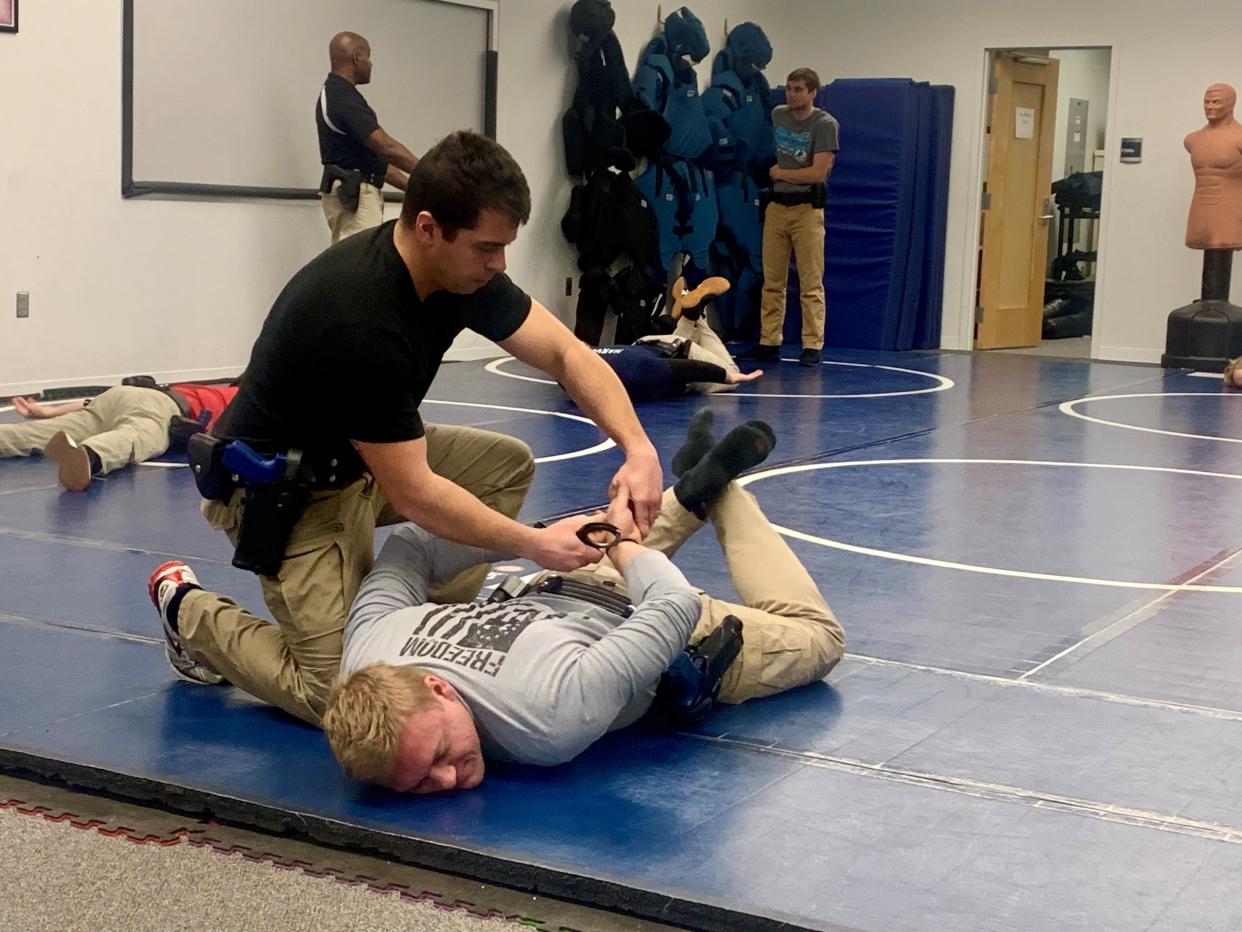
Ohio requires academy recruits to spend 70 hours — the longest amount of time on any single topic — learning subject control techniques.
Instructors David Fitzgerald, a retired Canton police officer, and retired Stark County sheriff's Lt. Rick Ady told the academy class in January that the techniques should be used to gain compliance, not inflict unnecessary pain.
They emphasized that only the amount of force necessary to make an arrest or protect themselves should be used, and the level of force used could change as the situation changes.
Fitzgerald also directed cadets to give suspects multiple opportunities to show whether they’re ready to comply.
For example, after pushing back a charging suspect, he advised the cadets to step back and to the side to assess whether the suspect plans to re-engage.
“He has to turn to come and get me,” Fitzgerald said. “That lets me know he is not going to comply.”
When a handcuffed suspect is lying face down on the floor, Fitzgerald said, crossing the suspect’s feet and folding them up will give the cadets a clue to the suspect’s intentions.
“Why are his legs up? Because in order for him to get up, he would have to put (his feet) back down," Fitzgerald said. "Then, he’s indicating to me what he’s planning to do. Or that he’s not going to be as cooperative as I thought."
The instructors stopped the cadets multiple times to correct their technique as they practiced taking a fellow cadet to the floor, handcuffing them and standing up a handcuffed suspect.
McClain’s mixed martial arts background helped him with the footwork that many of the other cadets lacked. Fitzgerald said the cadets need to use their feet to keep themselves out of the line of fire.
McClain said his martial arts training also helps him take a suspect to the floor.
“The practice doesn’t make me shy,” McClain said. “Getting into position, it doesn’t make me nervous to get close to somebody and put my hands on somebody because I practice it.”
Cadets test their training with scenarios
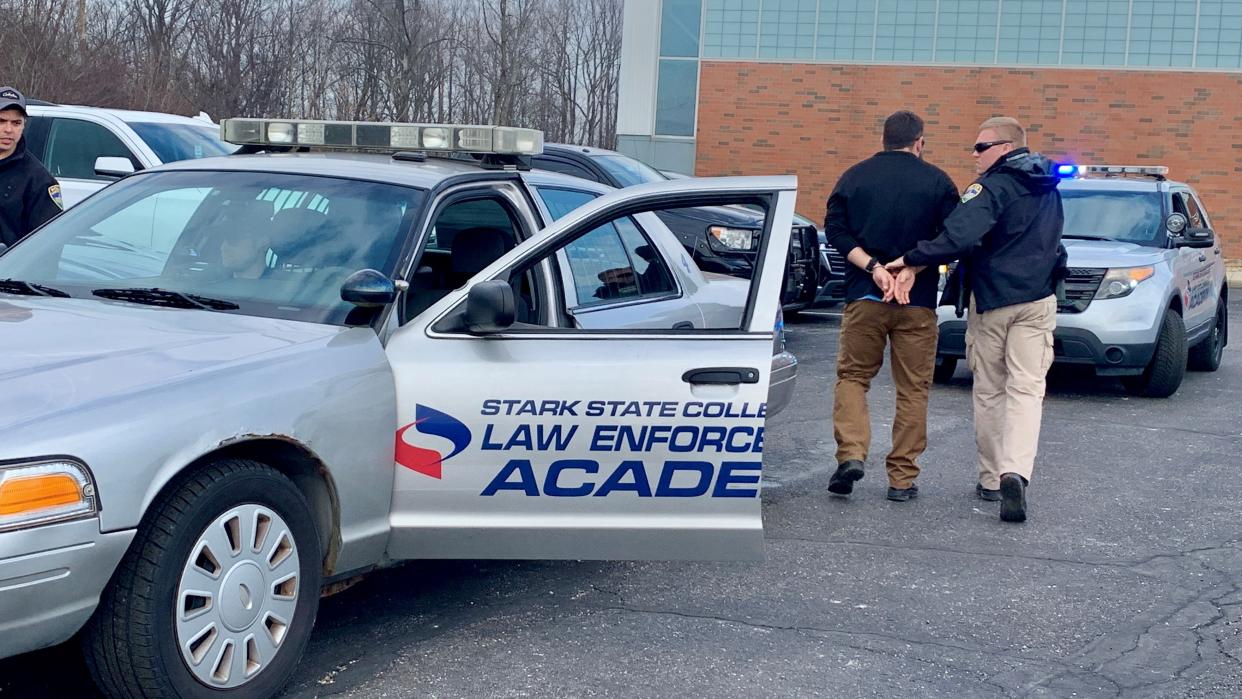
Stark State uses scenarios heavily in the final weeks of the academy to test whether students can combine and apply the concepts they learned in the classroom in real time. The scenarios ranged from routine traffic stops to high-risk situations, including a hunt for an armed suspect in a wooded area at night and a chase where the occupants were armed.
A high-risk vehicle stop training in February began with two police cruisers, their red and blue lights flashing, following a car to a dead-end drive behind the academy.
Cowling and Robb emerged from one cruiser with their guns drawn. Canton cadet Jake Narvet exited the other cruiser with the vehicle’s public address microphone ready.
“Passengers of the vehicle, show me your hands,” Narvet commanded over the speaker.
With methodical step-by-step commands, he instructed the driver to roll down the vehicle’s windows and to turn off the vehicle.
“Put the keys in your right hand. Use one hand to push your door open, driver,” he instructed.
Within 4 minutes, the driver was handcuffed, searched for weapons (at least one was found) and sitting in the back of a cruiser. Cowling then instructed the passenger out of the car using similar step-by-step commands. The passenger was handcuffed, searched and placed in the other cruiser without incident.
All they had left to do was check the vehicle’s backseat and trunk for any potential hidden passengers.
With guns still aimed at the vehicle, Cowling approached the passenger side while Robb took the driver’s side of the vehicle. The back seat was clear.
Robb went to open the trunk. It was locked.
He went to the front seat and searched the ignition, floor and door. No keys.
He checked the back seat. No keys.
Cowling, still aiming his rifle at the trunk, shifted his weight uncomfortably.
A cackling laugh could be heard coming from one of the cruisers. The handcuffed driver still had the keys.
The three cadets recovered quickly with Narvet, still by the cruisers, retrieving the keys from the driver and tossing them to Robb. The trunk was opened, revealing nothing inside.
The onlooking instructors, retired North Canton police officer Scott Coleman and retired Ohio State Highway Patrol trooper Rick Wells, deemed the trio's execution an overall success, and offered tips on spacing between them and the suspects, a reminder to check their surroundings more frequently and information on how to better use the cruiser as a shield.
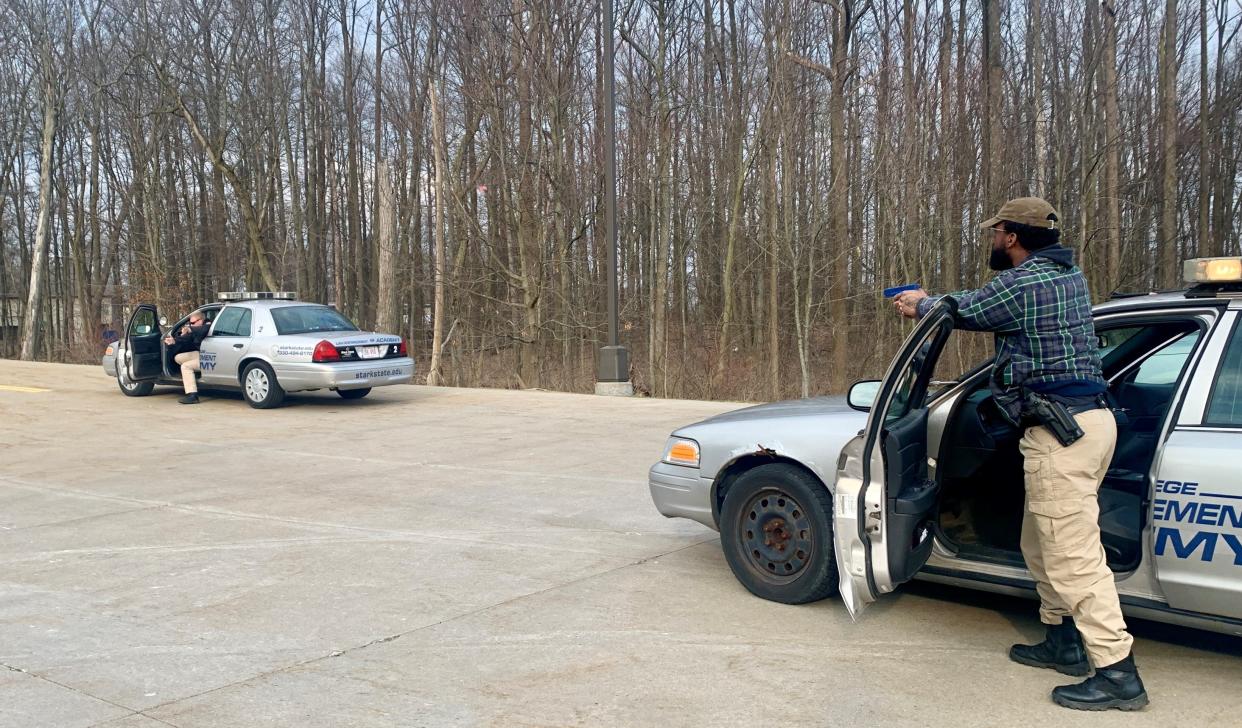
The other groups in the class didn’t fare as well on the training. A cadet bungled the instructions to get the driver out of the car, telling him to turn off the car and then roll down the car’s windows. One cadet didn’t shut the cruiser's door entirely when placing a suspect in the vehicle and then didn’t notice when the suspect walked away. Another cadet failed to find the weapon that the suspect hid in her sports bra during a pat-down search, resulting in burpees or push-ups and corrective instruction from the academy instructors.
“Are we better than what we were at 8 a.m.?” asked Coleman, who worked for North Canton police for 30 years before retiring in 2013. “Then we didn’t waste our time today.”
The Canton cadets underwent another eight hours of training on high-risk vehicle stops the following day at the Canton police department as part of the department's ongoing training for its officers.
McClain, Cowling and Robb each found the scenario-based training among the most engaging and helpful aspects of the academy. They believe the academy prepared them well.
Cowling said he would have preferred even more scenario-based sessions.
“I’m more of a hands-on learner,” he said. “I actually have to do it. That’s how I learn best.”
Robb said the scenarios forced him to think more as a team member.
“For the military, you want to take charge and deal with a situation on your own,” he said. “But here you have to work together.”
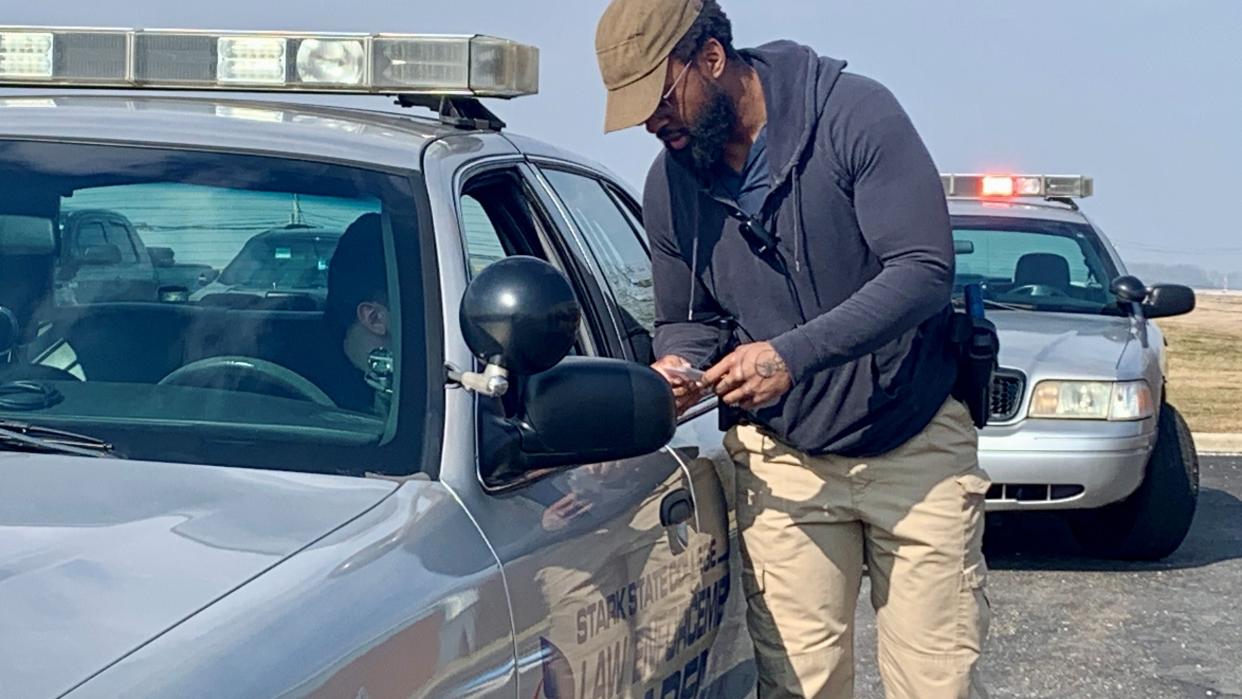
McClain, who grew up in southeast Canton, said learning the laws helped him challenge some notions of policing that he had heard growing up.
“As far as traffic stops, a lot of people assume that they were pulled over for no reason,” McClain said. “Well, usually there is a reason. Or (police) would be infringing upon your rights.
“I have never been pulled over wrongfully, so I had never experienced it. I would hear stories but I never got it myself so I wouldn’t understand it. Now, I’ve got an understanding that if you got pulled over, you were probably doing something wrong.”
State certification test looms
The last day of the academy ended on Feb. 28 with little fanfare.
Nine of the original 10 students in the class remained. One of the open-enrollment students had failed the physical fitness test twice, disqualifying him from moving forward.
The state certification test loomed for the rest. The other two open-enrollment students attained law enforcement jobs while in the academy, which meant, if they passed the test, they also could obtain their peace officer training certificate and not just a letter of completion. Officer certification in Ohio requires both completion of training and an appointment to a police agency.
Cowling was perhaps the most nervous for the state test. He struggles with testing anxiety, and had been noticeably stressed when taking the Taser operator certification assessment months ago.
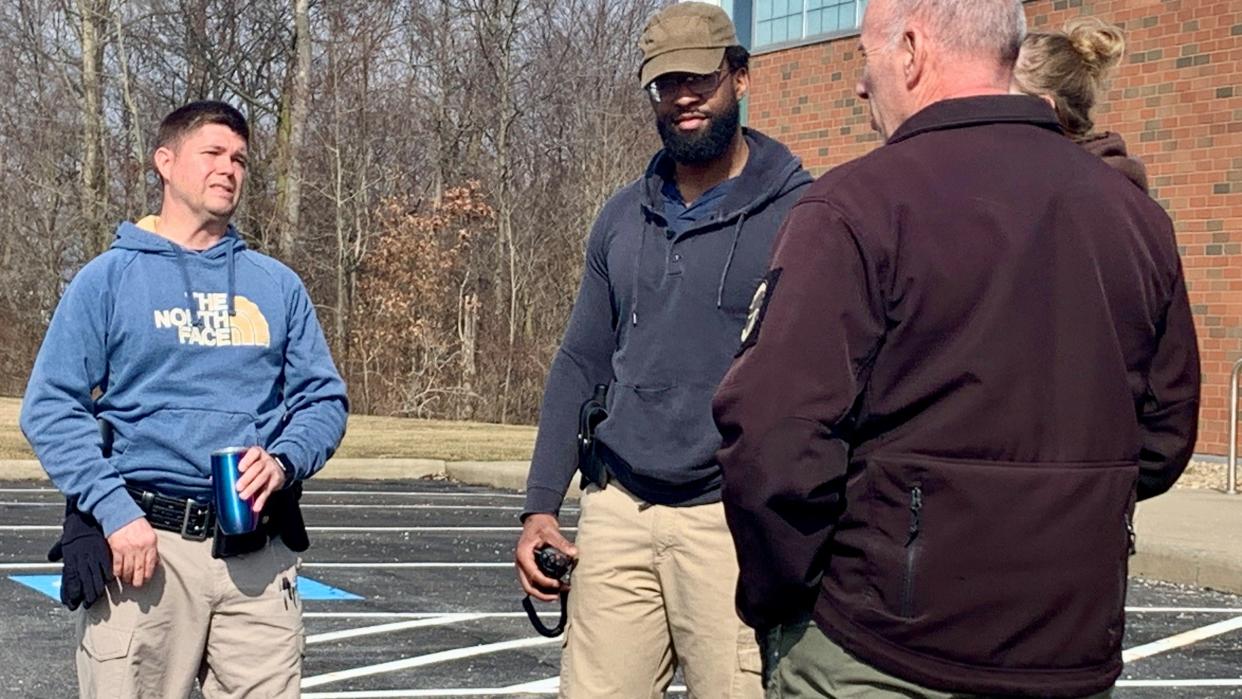
And this test had higher-than-most stakes.
Cadets have only two chances to pass the written exam. If they fail twice, the six months spent at the academy and the roughly $6,500 the Canton Police Department paid in tuition and fees would be wasted. They would also lose their jobs with the department for not meeting the standards for the job.
Last year, 96% of the 1,356 prospective officers passed the state test. Only two test-takers had failed this year as of March, according to figures provided by the Ohio Attorney General’s Office.
Test day for the Canton cadets was April 2, more than a month after they left the academy. At a state-approved testing center in Ravenna, each cadet was given a partitioned cubicle with a computer. They had 2.5 hours to answer 200 questions that covered the gamut of policing.
They needed to correctly answer at least 70% of the questions to pass.
At the 2.5-hour mark, a message wishing the candidate the best in their future endeavors flicked onto the computer screen. Then the screen went black.
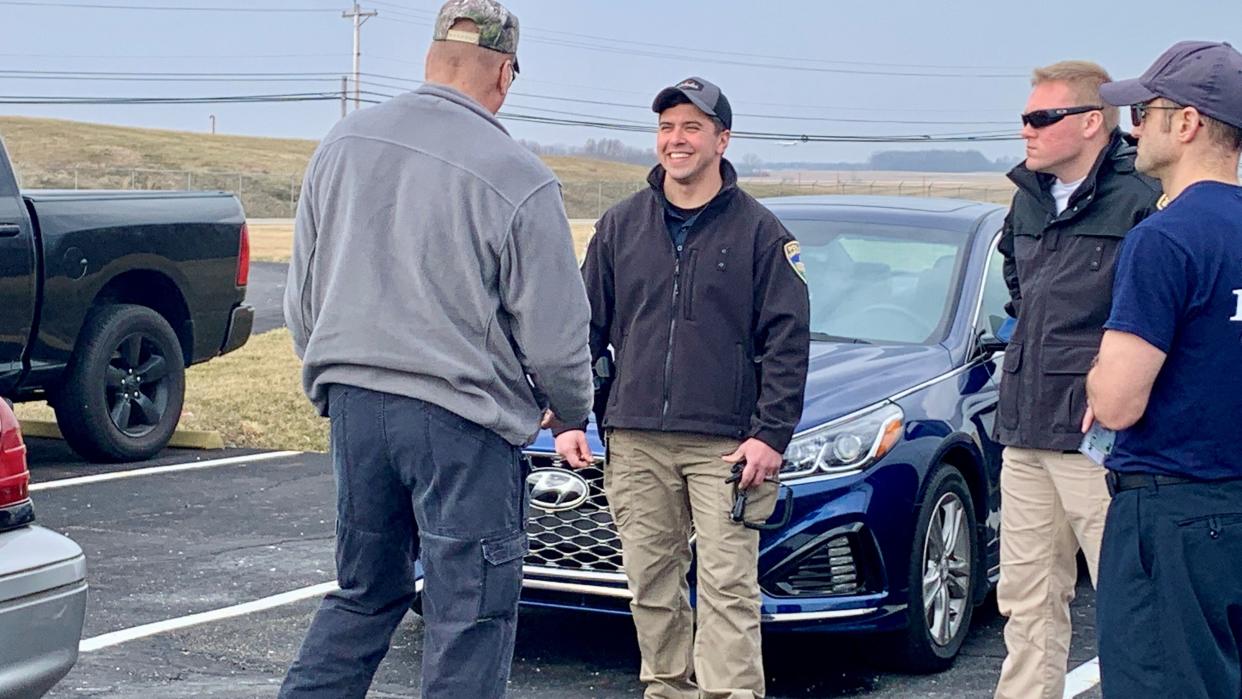
Robb was confident he passed, but was he among the top scorers? He wanted to do better than simply passing since Canton had invested the time and money in him to do the training.
“I knew I was going to pass,” Robb said. “But my mentality is, I wanted to be higher than the standard.”
Cowling still had three questions to answer when his screen flicked off.
“I freaked out a bit because I knew I was running out of time and I was trying to go as fast as I can,” he said.
McClain only made it to Question 190.
“I had my doubts. In taking the test, I felt confident in my answers. I felt prepared so the answers I made I felt were pretty correct,” he said. “But I ran out of time. I was taking a little more time than I needed to.”
As they each exited, the proctor handed them a paper with their outcome: They passed.
Cowling and Robb celebrated by getting lunch. McClain went to the gym.
They had to report to Canton’s police training center the next morning.
Their cadet training is far from over.
For the next 20 weeks, they will undergo Canton’s field training program where they will spend at least three weeks learning each patrol shift and a week with each the traffic bureau, detective bureau and the community priorities bureau, which addresses specific neighborhood issues. They also will undergo 40 hours of crisis intervention team training through the Stark County Mental Health & Addiction Recovery to learn how to respond to someone in a mental crisis. Their field training officer will evaluate their performance in August.
Cowling said he understands why the transition from the academy to field training could be difficult for some cadets. A Canton Repository analysis of Canton police officers hired since 2018 found that several officers resigned between their academy graduation and the end of their probationary period.
“There’s only so much they can do in the academy to get you ready,” Cowling said. “It comes down to your FTO (field training officer) to get you ready. That’s when you really find out if you like this job or not.”
Reach Canton Repository staff writer Kelli Weir at 330-580-8339 or kelli.weir@cantonrep.com.
This article originally appeared on The Repository: Canton City police cadets go to law enforcement academy
